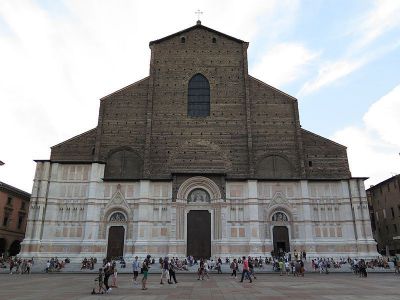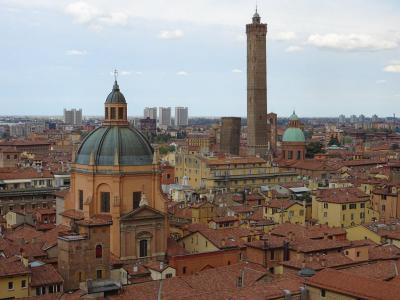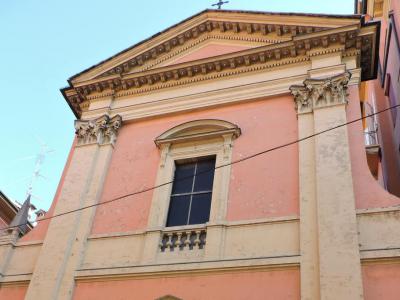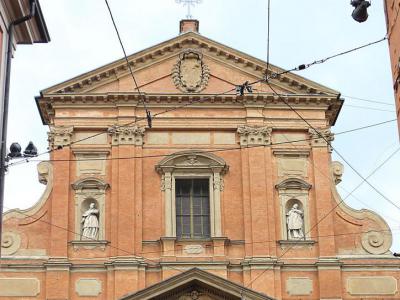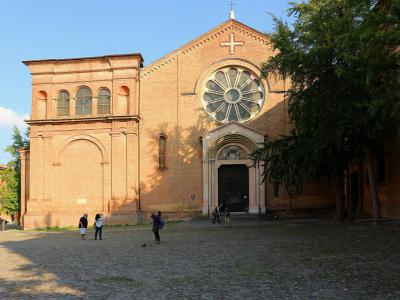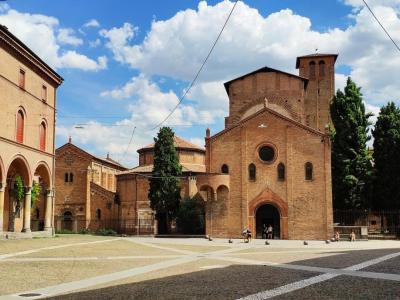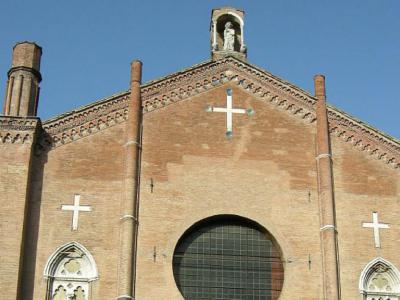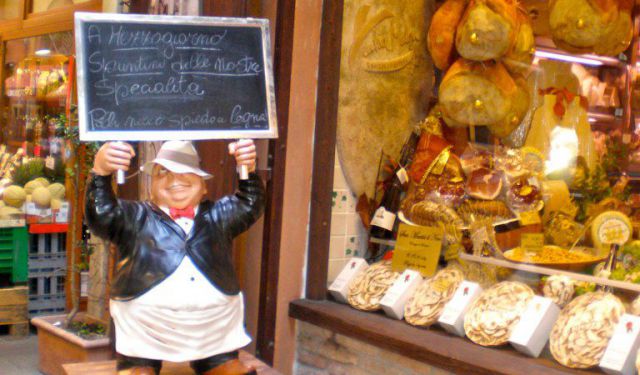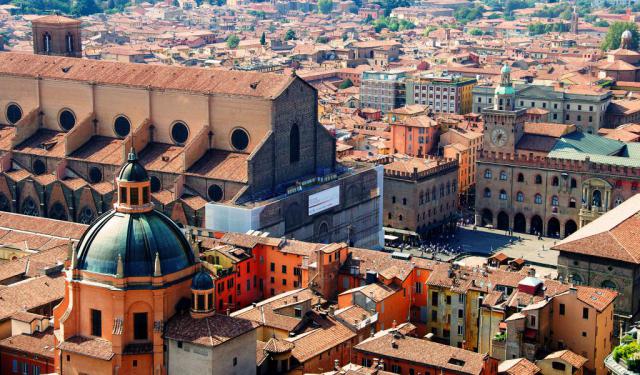
Historical Churches (Self Guided), Bologna
The historic city of Bologna is one of the most sumptuous medieval places in Italy, as well as one of the country's most visited destinations. There are churches everywhere in the city, many of which are well-preserved and well worth a visit. Magnificent and centuries-old, each of them has its own specialty and history carved into, replete with great historic artifacts associated with world renowned artists.
Such like, for instance, is the San Domenico Basilica that has a Michelangelo statue and a very particular piano that Mozart used to play whilst in Bologna.
Another no less remarkable religious object and a true example of Romanesque architecture is Santo Stefano (St. Stephen Complex) Basilica. Also known as Seven Churches or Holy Jerusalem, it was reportedly started by Saint Petronius himself, the patron saint of the city, and then continued in different styles over the period of 600 years. A definite must-see!
Among other religious sites you may want to visit in Bologna there are:
Basilica of San Petronio – dedicated to Saint Petronius, the most imposing church in the city; built throughout centuries since 1390.
Santa Maria della Vita (the Church of Holy Mary of Life) – established by Franciscan monk Raniero Fasani in 1260; one of its most remarkable attractions is the Lamentation over Dead Christ sculptural group.
San Paolo Maggiore Church – Baroque-style, Roman Catholic basilica commissioned between 1606 and 1611; richly adorned with frescoes, canvases and marble sculptures.
Basilica of San Domenico – one of Bologna’s major churches, holding the remains of Saint Dominic, founder of the Order of Preachers (Dominicans).
To explore these and other majestic churches on your stay in this fascinating old city, follow our self-guided walking tour.
Such like, for instance, is the San Domenico Basilica that has a Michelangelo statue and a very particular piano that Mozart used to play whilst in Bologna.
Another no less remarkable religious object and a true example of Romanesque architecture is Santo Stefano (St. Stephen Complex) Basilica. Also known as Seven Churches or Holy Jerusalem, it was reportedly started by Saint Petronius himself, the patron saint of the city, and then continued in different styles over the period of 600 years. A definite must-see!
Among other religious sites you may want to visit in Bologna there are:
Basilica of San Petronio – dedicated to Saint Petronius, the most imposing church in the city; built throughout centuries since 1390.
Santa Maria della Vita (the Church of Holy Mary of Life) – established by Franciscan monk Raniero Fasani in 1260; one of its most remarkable attractions is the Lamentation over Dead Christ sculptural group.
San Paolo Maggiore Church – Baroque-style, Roman Catholic basilica commissioned between 1606 and 1611; richly adorned with frescoes, canvases and marble sculptures.
Basilica of San Domenico – one of Bologna’s major churches, holding the remains of Saint Dominic, founder of the Order of Preachers (Dominicans).
To explore these and other majestic churches on your stay in this fascinating old city, follow our self-guided walking tour.
How it works: Download the app "GPSmyCity: Walks in 1K+ Cities" from Apple App Store or Google Play Store to your mobile phone or tablet. The app turns your mobile device into a personal tour guide and its built-in GPS navigation functions guide you from one tour stop to next. The app works offline, so no data plan is needed when traveling abroad.
Historical Churches Map
Guide Name: Historical Churches
Guide Location: Italy » Bologna (See other walking tours in Bologna)
Guide Type: Self-guided Walking Tour (Sightseeing)
# of Attractions: 7
Tour Duration: 1 Hour(s)
Travel Distance: 2.2 Km or 1.4 Miles
Author: vickyc
Sight(s) Featured in This Guide:
Guide Location: Italy » Bologna (See other walking tours in Bologna)
Guide Type: Self-guided Walking Tour (Sightseeing)
# of Attractions: 7
Tour Duration: 1 Hour(s)
Travel Distance: 2.2 Km or 1.4 Miles
Author: vickyc
Sight(s) Featured in This Guide:
- Basilica di San Petronio (Basilica of St. Petronius)
- Santuario di Santa Maria della Vita (Sanctuary of Holy Mary of Life)
- Chiesa di San Giovanni Battista dei Celestini (Church of St. John the Baptist)
- Chiesa di San Paolo Maggiore (Church of St. Paul the Greater)
- Basilica di San Domenico (Basilica of St. Dominic)
- Complesso di Santo Stefano (St. Stephen's Complex)
- Basilica di San Giacomo Maggiore (Basilica of Saint James the Greater)
1) Basilica di San Petronio (Basilica of St. Petronius) (must see)
Dedicated to Petronius, the city's patron saint, this 14th-century edifice stands as Bologna's principal church, containing an impressive 22 side chapels and featuring the Four Crosses, one of the oldest Christian symbols in the city. As one of Italy's most monumental Gothic basilicas, capable of housing up to 28,000 people, it was on track to surpass Saint Peter's in Rome until Pope Pius IV diverted funds to establish a new university, the Archiginnasio. Consequently, the façade, designed with cosmological and esoteric "diagramming", was left incomplete, with only partial cladding in pink Verona marble and a truncated transept visible down the alley to the right of the basilica. Nonetheless, San Petronio remains monumental, symbolizing civic will rather than religious authority. Built atop Roman foundations, the vaulted church reveals columns repurposed from the Augustan era, seamlessly integrated with medieval additions.
The Porta Magna, or central portal, features highly expressive reliefs, the final masterpiece of Sienese sculptor Jacopo della Quercia, which occupied the last 13 years of his life (1425−38). Adorning the architrave are scenes from the New Testament, while dramatic reliefs on the two pilasters flanking the door depict scenes from the Old Testament. Michelangelo, during his visit to Bologna in 1494, admired these reliefs and incorporated several motifs – such as "The Creation of Adam" – into the Sistine Ceiling. The lunette above the portal showcases the Madonna and Child between Saint Petronius and Saint Ambrose.
Also inside lies the world's longest indoor meridian line, inlaid into the pavement of the left aisle in 1655. Stretching 66.8 meters (219.16 feet), it was calculated and designed by astronomer Giovanni Cassini, who taught astronomy at the University. A sunray enters from a hole in the vault 27 meters high and precisely strikes the line, enabling accurate time measurement.
Tips:
Admission is free, but there's a small fee for photography. Visitors should adhere to the dress code, ensuring that shoulders and knees are covered. From the newly renovated panoramic terrace (reachable from Piazza Galvani via elevator and a short flight of stairs), one can enjoy magnificent views of the cityscape and the Apennine hills to the south.
The Porta Magna, or central portal, features highly expressive reliefs, the final masterpiece of Sienese sculptor Jacopo della Quercia, which occupied the last 13 years of his life (1425−38). Adorning the architrave are scenes from the New Testament, while dramatic reliefs on the two pilasters flanking the door depict scenes from the Old Testament. Michelangelo, during his visit to Bologna in 1494, admired these reliefs and incorporated several motifs – such as "The Creation of Adam" – into the Sistine Ceiling. The lunette above the portal showcases the Madonna and Child between Saint Petronius and Saint Ambrose.
Also inside lies the world's longest indoor meridian line, inlaid into the pavement of the left aisle in 1655. Stretching 66.8 meters (219.16 feet), it was calculated and designed by astronomer Giovanni Cassini, who taught astronomy at the University. A sunray enters from a hole in the vault 27 meters high and precisely strikes the line, enabling accurate time measurement.
Tips:
Admission is free, but there's a small fee for photography. Visitors should adhere to the dress code, ensuring that shoulders and knees are covered. From the newly renovated panoramic terrace (reachable from Piazza Galvani via elevator and a short flight of stairs), one can enjoy magnificent views of the cityscape and the Apennine hills to the south.
2) Santuario di Santa Maria della Vita (Sanctuary of Holy Mary of Life) (must see)
Just a stone's throw east of the bustling Main Square ("Piazza Maggiore"), the Church of Holy Mary of Life offers a serene retreat. Despite its boldly frescoed 17th-century High Baroque interior, the true highlight is Niccolò dell'Arca's "Lamentation over the Dead Christ" (1463), a remarkable terracotta composition depicting life-size mourners grieving the death of Christ.
It's said that dell'Arca drew inspiration from the faces of the sick and suffering in the religious hospital complex where the church once belonged, capturing their raw expressions of grief with remarkable skill (apparently, the figure of Nicodemus is a self-portrait of the artist himself). Meanwhile, in the oratory, which hosts temporary exhibitions, visitors can find another poignant terracotta masterpiece: Alfonso Lombardi's "Death of the Virgin", which again presents an unusual perspective on a familiar story.
It's said that dell'Arca drew inspiration from the faces of the sick and suffering in the religious hospital complex where the church once belonged, capturing their raw expressions of grief with remarkable skill (apparently, the figure of Nicodemus is a self-portrait of the artist himself). Meanwhile, in the oratory, which hosts temporary exhibitions, visitors can find another poignant terracotta masterpiece: Alfonso Lombardi's "Death of the Virgin", which again presents an unusual perspective on a familiar story.
3) Chiesa di San Giovanni Battista dei Celestini (Church of St. John the Baptist)
Established by Pietro da Morrone, later known as Pope Celestine V, the Celestine monks arrived in Bologna in 1368 at the invitation of Antonio Galluzzi, who generously provided them with a monastery and a church dedicated to Saint John the Baptist. Over time, the complex underwent significant expansions and renovations, particularly during the 16th century, with its form largely preserved through an 18th-century reconstruction. Although the Celestines were disbanded in 1797, the church remained in use for religious services.
Originally intended to house the meeting hall of the Council of Thirty, plans for adapting the convent included demolishing certain buildings owned by Pompeo Fontana to create additional space; however, these plans were never realized. Instead, in September 1798, the convent was repurposed to oversee the administration of the lottery. Subsequently, it served various functions such as hosting the Registry office, conscripts' bureau, and archives of suppressed religious entities. In the mid-19th century, it underwent renovations to accommodate the School of Engineering Application and presently serves as the home of the State Archives.
Although the exterior may not be particularly striking or remarkable, the intricate and somewhat dramatic frescoes on the walls and ceilings certainly make the visit worthwhile. The artworks found on the main altar and in the side chapels are also worth admiring.
Originally intended to house the meeting hall of the Council of Thirty, plans for adapting the convent included demolishing certain buildings owned by Pompeo Fontana to create additional space; however, these plans were never realized. Instead, in September 1798, the convent was repurposed to oversee the administration of the lottery. Subsequently, it served various functions such as hosting the Registry office, conscripts' bureau, and archives of suppressed religious entities. In the mid-19th century, it underwent renovations to accommodate the School of Engineering Application and presently serves as the home of the State Archives.
Although the exterior may not be particularly striking or remarkable, the intricate and somewhat dramatic frescoes on the walls and ceilings certainly make the visit worthwhile. The artworks found on the main altar and in the side chapels are also worth admiring.
4) Chiesa di San Paolo Maggiore (Church of St. Paul the Greater)
Constructed in the early 1600s in Baroque style, this church was commissioned by the Barnabites, a Catholic order belonging to the Clerics Regular of Saint Paul. In the 1630s, its elegant façade in brick and stone, adorned with statues of Saints Peter and Paul, was added.
Inside, the vaults were splendidly decorated by Antonio and Giuseppe Rolli, illustrating the exploits of Saint Paul at the Areopagus in Athens (Antonio tragically died after a fall from a scaffold, and his brother completed the work). Above the altar, notable paintings by renowned Bolognese artists such as Guercino, Giuseppe Maria Crespi, and Lodovico Carracci depict the famous "Paradiso". The opulent high altar is particularly striking, featuring a sculpture of the "Decollation of Saint Paul", commissioned by the Barnabites and crafted by the Bolognese artist Alessandro Algardi (who also created the medallion adorning the front of the altar and the tabernacle).
Church and art enthusiasts will undoubtedly find ample delight here, as myriad intricate details beckon admiration. And once you've indulged your eyes, you can bask in the tranquility and serenity of the surroundings.
Inside, the vaults were splendidly decorated by Antonio and Giuseppe Rolli, illustrating the exploits of Saint Paul at the Areopagus in Athens (Antonio tragically died after a fall from a scaffold, and his brother completed the work). Above the altar, notable paintings by renowned Bolognese artists such as Guercino, Giuseppe Maria Crespi, and Lodovico Carracci depict the famous "Paradiso". The opulent high altar is particularly striking, featuring a sculpture of the "Decollation of Saint Paul", commissioned by the Barnabites and crafted by the Bolognese artist Alessandro Algardi (who also created the medallion adorning the front of the altar and the tabernacle).
Church and art enthusiasts will undoubtedly find ample delight here, as myriad intricate details beckon admiration. And once you've indulged your eyes, you can bask in the tranquility and serenity of the surroundings.
5) Basilica di San Domenico (Basilica of St. Dominic) (must see)
Via Castiglione once served as the main route to the Bolognese hills, with access controlled by Porta Castiglione, one of the city's ten surviving gates. To the west, the monumental Basilica of Saint Dominic (with a fee for entry to the presbytery only) presides over the cobblestone Piazza San Domenico. The square has two notable mausoleums, each featuring a tomb raised on pillars and sheltered by a canopy, dedicated to renowned medieval law scholars Rolandino de' Passaggeri and Egidio Foscherari.
The basilica was originally built to house the relics of Saint Dominic, the founder of the Dominican order who passed away here in 1221 and was canonized in 1234. Despite having undergone alterations over the years, the structure still abounds in curious, canopied tombs and artworks by renowned artists such as Michelangelo, Pisano, and Filippino Lippi, alongside works by prominent Bolognese artists.
The Chapel of Saint Dominic holding the saint's tomb is halfway down the basilica on the right. The magnificent Tomb of Saint Dominic ("Arca di San Domenico") is a collaborative effort by several leading artists, including Niccolò da Bari (later known as Niccolò dell'Arca for his outstanding work here), Nicola Pisano, and Arnolfo di Cambio. Completed by Michelangelo, who was a mere 19-year-old at the time, the Arca features two Bolognese saints – Proculus and Petronius – holding a model of Bologna.
Decorating the dome above the Arca is Guido Reni's "Saint Dominic in Glory with Christ, the Madonna, and Saints", while hidden behind the shrine lies the precious reliquary of Saint Dominic's head. Other notable artworks include Giunta Pisano's "Crucifix" (1250) and the tomb of Taddeo Pepoli, both located in the left transept; Filippino Lippi's "Mystical Marriage of Saint Catherine" in the small chapel beyond the right transept; and the exquisite mid-sixteenth-century marquetry choir stalls.
The basilica was originally built to house the relics of Saint Dominic, the founder of the Dominican order who passed away here in 1221 and was canonized in 1234. Despite having undergone alterations over the years, the structure still abounds in curious, canopied tombs and artworks by renowned artists such as Michelangelo, Pisano, and Filippino Lippi, alongside works by prominent Bolognese artists.
The Chapel of Saint Dominic holding the saint's tomb is halfway down the basilica on the right. The magnificent Tomb of Saint Dominic ("Arca di San Domenico") is a collaborative effort by several leading artists, including Niccolò da Bari (later known as Niccolò dell'Arca for his outstanding work here), Nicola Pisano, and Arnolfo di Cambio. Completed by Michelangelo, who was a mere 19-year-old at the time, the Arca features two Bolognese saints – Proculus and Petronius – holding a model of Bologna.
Decorating the dome above the Arca is Guido Reni's "Saint Dominic in Glory with Christ, the Madonna, and Saints", while hidden behind the shrine lies the precious reliquary of Saint Dominic's head. Other notable artworks include Giunta Pisano's "Crucifix" (1250) and the tomb of Taddeo Pepoli, both located in the left transept; Filippino Lippi's "Mystical Marriage of Saint Catherine" in the small chapel beyond the right transept; and the exquisite mid-sixteenth-century marquetry choir stalls.
6) Complesso di Santo Stefano (St. Stephen's Complex) (must see)
Navigating through this ecclesiastical maze, a pilgrimage through Bologna's holiest sites, demands patience and time. Originally a complex of seven churches, akin to Jerusalem's architecture, it is known as Le Sette Chiese ("the Seven Churches"), though only four endure today. Dating back to the 5th century, Santo Stefano may have been established by Bishop Petronius as his cathedral atop a former pagan temple site; by the 10th century, however, it evolved into a Benedictine sanctuary. The complex is still overseen by stern Benedictines, one of whom reveals: "Dante often came here to meditate in 1287, but we are inclusive - even local prostitutes come here."
The interconnected churches and courtyards, including the Benedictine cloisters, create a harmonious ensemble. From the picturesque square, the larger church on the right is the Church of the Crucifix ("Chiesa del Crocifisso"), the central one is the Basilica of "San Sepolcro", modeled after Jerusalem's Holy Sepulchre, and on the left stands Santi Vitale e Agricola, Bologna's oldest church.
Enter through the Church of the Crucifix, originally Lombard but extensively renovated. Ascend a central staircase to the Presbytery, then descend to a graceful crypt housing relics of early Bolognese martyrs Vitale and Agricola. A door on the left leads to the Basilica of the Holy Sepulchre, a unique polygonal structure surrounded by ancient columns.
Bathed in mystical light, the 11th-century Santi Vitale e Agricola captivates with its Romanesque Lombard simplicity. Adjacent is Pilate's Courtyard ("Cortile di Pilato"), featuring a marble basin erroneously attributed to Pontius Pilate, while beyond lies the mysterious Martyrium, a transverse church illuminated by niches, including one displaying a sculpted scene by Bolognese artist Simone de' Crocifissi.
The peaceful Benedictine cloister features two tiers of loggias and houses a small museum of early Bolognese paintings and reliquaries, along with a shop offering liqueurs and lotions produced by the monks.
The interconnected churches and courtyards, including the Benedictine cloisters, create a harmonious ensemble. From the picturesque square, the larger church on the right is the Church of the Crucifix ("Chiesa del Crocifisso"), the central one is the Basilica of "San Sepolcro", modeled after Jerusalem's Holy Sepulchre, and on the left stands Santi Vitale e Agricola, Bologna's oldest church.
Enter through the Church of the Crucifix, originally Lombard but extensively renovated. Ascend a central staircase to the Presbytery, then descend to a graceful crypt housing relics of early Bolognese martyrs Vitale and Agricola. A door on the left leads to the Basilica of the Holy Sepulchre, a unique polygonal structure surrounded by ancient columns.
Bathed in mystical light, the 11th-century Santi Vitale e Agricola captivates with its Romanesque Lombard simplicity. Adjacent is Pilate's Courtyard ("Cortile di Pilato"), featuring a marble basin erroneously attributed to Pontius Pilate, while beyond lies the mysterious Martyrium, a transverse church illuminated by niches, including one displaying a sculpted scene by Bolognese artist Simone de' Crocifissi.
The peaceful Benedictine cloister features two tiers of loggias and houses a small museum of early Bolognese paintings and reliquaries, along with a shop offering liqueurs and lotions produced by the monks.
7) Basilica di San Giacomo Maggiore (Basilica of Saint James the Greater)
Overlooking Piazza Rossini stands the Basilica of Saint James the Greater, also known as the Bentivoglio family's church, offering free entry to visitors. The Romanesque facade and lion-flanked portals predate Bologna's illustrious dynasty, while the graceful Renaissance portico, along with many splendid paintings in their family chapel, date from their era (follow the signage upon entering the church). Although the chapel is only open on Saturday mornings (from 9:30 AM to 12:30 PM), it can be observed through the railings.
Notable works include the "Madonna and Child" (1488) and the evocative "Triumph of Death and Triumph of Fame", both crafted by the Ferrarese painter Lorenzo Costa. The Bentivoglio Altarpiece ("The Madonna and Child"), depicting Giovanni il Bentivoglio, his spouse, and eleven children, was purportedly commissioned in gratitude for the family's survival of an attempted massacre by a rival clan. Also noteworthy is "The Madonna and Saints" (1494) by Francesco Raibolini, considered among the artist's finest altarpieces.
Notable works include the "Madonna and Child" (1488) and the evocative "Triumph of Death and Triumph of Fame", both crafted by the Ferrarese painter Lorenzo Costa. The Bentivoglio Altarpiece ("The Madonna and Child"), depicting Giovanni il Bentivoglio, his spouse, and eleven children, was purportedly commissioned in gratitude for the family's survival of an attempted massacre by a rival clan. Also noteworthy is "The Madonna and Saints" (1494) by Francesco Raibolini, considered among the artist's finest altarpieces.
Walking Tours in Bologna, Italy
Create Your Own Walk in Bologna
Creating your own self-guided walk in Bologna is easy and fun. Choose the city attractions that you want to see and a walk route map will be created just for you. You can even set your hotel as the start point of the walk.
Bologna Palaces
Bologna is famous for a huge number of ancient buildings and unique historic sites, closely associated with a huge number of mysteries and legends. There are numerous incredibly beautiful palaces in the city, richly adorned with art by great masters, intricately decorated interiors and luxurious old furniture. Each palace is fit to leave an unforgettable impression upon visitors, firmly imprinted... view more
Tour Duration: 1 Hour(s)
Travel Distance: 1.4 Km or 0.9 Miles
Tour Duration: 1 Hour(s)
Travel Distance: 1.4 Km or 0.9 Miles
Bologna's Shopping Areas
When it comes to shopping, Bologna walks tall amid grands like Milan or Rome, with a harmonious mix of international chains, exclusive boutiques, luxury stores and open-air markets lining the streets in the city center, offering a wealth of international fashion, designer brands and top quality local delicacies in rich supply.
Shopping here is particularly pleasant on weekends when Zone... view more
Tour Duration: 1 Hour(s)
Travel Distance: 0.8 Km or 0.5 Miles
Shopping here is particularly pleasant on weekends when Zone... view more
Tour Duration: 1 Hour(s)
Travel Distance: 0.8 Km or 0.5 Miles
Bologna Introduction Walking Tour
Bologna is the Emilia-Romagna region's capital. This large northern city is the seventh most populous city in Italy and has been a vital cultural center for millennia.
Archeological discoveries indicate the area has been settled since the third millennium BC. First, the Etruscans settled the area, then the Celts, and then the Romans. During the Middle Ages, Bologna was a free municipality... view more
Tour Duration: 2 Hour(s)
Travel Distance: 2.3 Km or 1.4 Miles
Archeological discoveries indicate the area has been settled since the third millennium BC. First, the Etruscans settled the area, then the Celts, and then the Romans. During the Middle Ages, Bologna was a free municipality... view more
Tour Duration: 2 Hour(s)
Travel Distance: 2.3 Km or 1.4 Miles
The Most Popular Cities
/ view all
